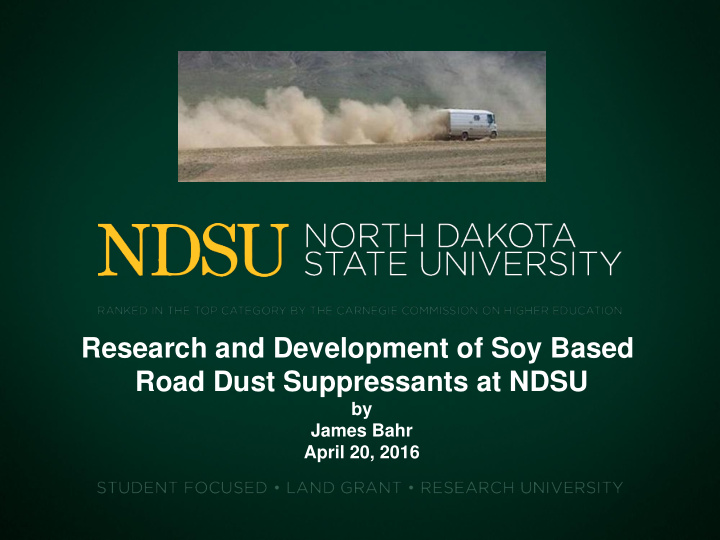



Research and Development of Soy Based Road Dust Suppressants at NDSU by James Bahr April 20, 2016
The Problem • Over 1.3 million miles of unpaved roads in US • Fugitive road dust generated is a hazard for people, livestock and crops • Current widespread use of magnesium and calcium chloride create environmental concerns and cause corrosion to vehicles and infrastructure • With population growth, more roads are being treated with chlorides • Better options for road dust mitigation are needed
Objectives • Utilize waste glycerol from biodiesel production to synthesize road dust suppressants (~200 million gallons generated per year) • Combine crude glycerol with soy based products to create a dust suppression agent that is water dispersible and crosslink forming • Reduce the current use of corrosive salts on gravel roads by developing alternative technologies • Produce a dust control product that wont easily wash away in the rain (longer lasting) • Produce a dust control product that is non-toxic, non-corrosive and biodegradable (safe for the environment)
Laboratory Synthesis • Dual 10 liter glass reactors • Excellent thermal control • Vacuum distillation • Periodic sample collection • Extensive track record of Soy based material synthesis • High pressure reactor available- 6 liter 3,000 psi
Materials Made HPLC analysis to monitor conversion Over 40 batches yielding 160 samples Form emulsion in water Apply to class 5 gravel
Technical Approach Testing Apply treatments to 10 lbs. Dry/cure treated samples Modified cement mixer of class 5 gravel for dust collection
Preliminary Findings • Non hardening, low odor • Product easily dispersed in water • Forms a stable emulsion • Works in very dry conditions • Is not easily washed away • One step synthesis in less than 2 hrs • Provisional patent filed last fall
Benefits of this Technology • Increased demand for biodiesel waste products • More options for dust control on gravel roads • Non-corrosive and biodegradable • Minimize the use of corrosive salts currently used on gravel roads • Expanded market for soybean oil
Future Work- 2 nd Year Funding • Transition from lab scale testing to road testing • Synthesize large quantities of soy based dust control agent • Work with state and local agencies to test on gravel roads • Apply dust control agents to roadbed and monitor for 3 months • Find an industrial partner that can commercialize the technology
Future Road Testing • Section of gravel road on the NDSU campus (daily monitoring) • Section of rural Cass County road (heavy traffic) TBD
Road Dust Measurement Road dust generation will be measured with a vehicle mounted particulate monitoring system similar to this setup developed at Penn State. Respirable aerosol concentrations of PM 10 will be measured in real-time.
Partnering with NDSU Center for Advanced Technology Development and Commercialization (CATCOM) • Purpose- Improve and refine NDSU and/or private sector inventions leading to the manufacturing of new products • Match requirements- $2 from private sector (cash/in-kind) per $1 of state funds Research ND • Purpose- Create a long term positive economic impact on the state through the development of new markets • Match Requirements- $1 from private sector per $1 of state funds, no in-kind
Acknowledgment Questions?
Recommend
More recommend